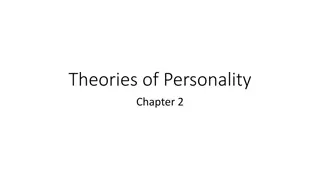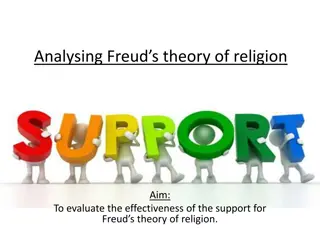Understanding Personality: Freud's Psychoanalytic Theory
Personality encompasses unique ways individuals think, feel, and behave. Sigmund Freud's psychoanalytic theory explores the divisions of consciousness, parts of personality (Id, Ego, Superego), and stages of personality development. Freud's theory delves into the role of unconscious thoughts, desires, and early experiences in shaping individual behaviors and traits.
Download Presentation

Please find below an Image/Link to download the presentation.
The content on the website is provided AS IS for your information and personal use only. It may not be sold, licensed, or shared on other websites without obtaining consent from the author. Download presentation by click this link. If you encounter any issues during the download, it is possible that the publisher has removed the file from their server.
E N D
Presentation Transcript
Personality Personality - the unique and relatively stable ways in which people think, feel, and behave. Character - value judgments of a person s moral and ethical behavior. Temperament - the enduring characteristics with which each person is born.
Four Perspectives in Study of Personality Psychoanalytic Behavioristic (including social cognitive theory) Humanistic Trait perspectives
Sigmund Freud Founder of the psychoanalytic movement in psychology. Europe during the Victorian age. A bit sexually repressed Table limbs must be covered as well as human ones Freud was doted on by his mother but did not get along well with his father who was a bit stern Moved to England in 1938 to escape the Nazis
Divisions of Consciousness Preconscious mind - level of the mind in which information is available but not currently conscious. Conscious mind - level of the mind that is aware of immediate surroundings and perceptions. Unconscious mind - level of the mind in which thoughts, feelings, memories, and other information are kept that are not easily or voluntarily brought into consciousness. Can be revealed in dreams and Freudian slips of the tongue.
Freuds Theory: Parts of Personality Id -part of the personality present at birth and completely unconscious. Libido - the instinctual energy that may come into conflict with the demands of a society s standards for behavior. Pleasure principle - principle by which the id functions; the immediate satisfaction of needs without regard for the consequences. Ego - part of the personality that develops out of a need to deal with reality, mostly conscious, rational, and logical. Reality principle - principle by which the ego functions; the satisfaction of the demands of the id only when negative consequences will not result. Superego - part of the personality that acts as a moral center. Ego ideal - part of the superego that contains the standards for moral behavior. Conscience - part of the superego that produces pride or guilt, depending on how well behavior matches or does not match the ego ideal.
Freuds Theory: Stages of Personality Development Fixation - disorder in which the person does not fully resolve the conflict in a particular psychosexual stage, resulting in personality traits and behavior associated with that earlier stage. Psychosexual stages - five stages of personality development proposed by Freud and tied to the sexual development of the child.
Freuds Theory: Stages of Personality Development Oral stage - first stage occurring in the first year of life in which the mouth is the erogenous zone and weaning is the primary conflict. Id dominated.
Freuds Theory: Stages of Personality Development Anal stage - second stage occurring from about 1 to 3 years of age, in which the anus is the erogenous zone and toilet training is the source of conflict. Ego develops. Anal expulsive personality - a person fixated in the anal stage who is messy, destructive, and hostile. Anal retentive personality - a person fixated in the anal stage who is neat, fussy, stingy, and stubborn.
Freuds Theory: Stages of Personality Development Phallic stage - third stage occurring from about 3 to 6 years of age, in which the child discovers sexual feelings. Superego develops. Oedipus/Electra complex- situation occurring in the phallic stage in which a child develops a sexual attraction to the opposite-sex parent and jealousy of the same-sex parent. Identification - defense mechanism in which a person tries to become like someone else to deal with anxiety.
Freuds Theory: Stages of Personality Development Latency - fourth stage occurring during the school years, in which the sexual feelings of the child are repressed while the child develops in other ways. Genital sexual feelings reawaken with appropriate targets.
Freuds Psychoanalysis Psychoanalysis - Freud s term for both the theory of personality and the therapy based on it.
Neo-Freudians Neo-Freudians - followers of Freud who developed their own competing theories of psychoanalysis. Jung developed a theory of a collective unconscious. Personal unconscious - Jung s name for the unconscious mind as described by Freud. Collective unconscious Jung s name for the memories shared by all members of the human species. Archetypes - Jung s collective, universal human memories.
Neo-Freudians Adler proposed feelings of inferiority as the driving force behind personality and developed birth order theory. Horney developed a theory based on basic anxiety and rejected the concept of penis envy. Basic anxiety - anxiety created when a child is born into the bigger and more powerful world of older children and adults. Neurotic personalities maladaptive ways of dealing with relationships in Horney s theory. Erikson developed a theory based on social rather than sexual relationships, covering the entire life span.
Erikson Trust versus mistrust - first stage of personality development in which the infant s basic sense of trust or mistrust develops as a result of consistent or inconsistent care. Autonomy versus shame and doubt - second stage of personality development in which the toddler strives for physical independence. Initiative versus guilt - third stage of personality development in which the preschool-aged child strives for emotional and psychological independence and attemps to satisfy curiosity about the world.
Eriksons Stages 2 Industry versus inferiority - fourth stage of personality development in which the child strives for a sense of competence and self- esteem. Identity versus identity diffusion fifth stage in which adolescents decide who they are and what they want to do as they become adults
Eriksons Stages 3 Intimacy versus isolation sixth stage in which adults in their 20 s and 30 s form intimate relationships Generativity versus stagnation seventh stage in which middle aged adults help the younger generation and leave a legacy for the world Integrity versus despair older adults reflect on their lives and if they feel it was well spent they experience a sense of integrity, if not they may experience despair and regret
Modern Psychoanalytic Theory Current research has found support for: Defense mechanisms Concept of an unconscious mind that can influence conscious behavior Benefit of one on one therapies and seeking insight in therapy Basic observations of what children are like at different ages but not always the reasons Importance of sense of self and ability to delay gratification Other concepts cannot be scientifically researched.
Behaviorism and Personality Behaviorists define personality as a set of learned responses or habits. Habits - in behaviorism, sets of well-learned responses that have become automatic. Social cognitive learning theorists theorists who emphasize the importance of both the influences of other people s behavior and of a person s own expectancies on learning. Social cognitive view learning theory that includes cognitive processes such as anticipating, judging, memory, and imitation of models.
Behaviorism and Personality Reciprocal determinism - Bandura s explanation of how the factors of environment, personal characteristics, and behavior can interact to determine future behavior. Self-efficacy individual s perception of how effective a behavior will be in any particular circumstance (NOT the same as self-esteem).
Humanistic Theories of Personality Humanistic perspective - the third force in psychology that focuses on those aspects of personality that make people uniquely human, such as subjective feelings and freedom of choice. Developed as a reaction against the negativity of psychoanalysis and the deterministic nature of behaviorism.
Rogers Theory of Personality Self-actualizing tendency the striving to fulfill one s innate capacities and capabilities. Self-concept - the image of oneself that develops from interactions with important, significant people in one s life. Self - archetype that works with the ego to manage other archetypes and balance the personality. Real self - one s perception of actual characteristics, traits, and abilities. Ideal self - one s perception of whom one should be or would like to be.
Rogers Theory of Personality Positive regard warmth, affection, love, and respect that come from significant others in one s life. Unconditional positive regard - positive regard that is given without conditions or strings attached. Conditional positive regard- positive regard that is given only when the person is doing what the providers of positive regard wish. Fully functioning person a person who is in touch with and trusting of the deepest, innermost urges and feelings.
Trait Theories of Personality Trait theories - theories that endeavor to describe the characteristics that make up human personality in an effort to predict future behavior. Trait - a consistent, enduring way of thinking, feeling, or behaving. Allport first developed a list of about 200 traits and believed that these traits were part of the nervous system. Cattell reduced the number of traits to between 16 and 23 with a statistical method called factor analysis.
Trait Theories of Personality Surface traits - aspects of personality that can easily be seen by other people in the outward actions of a person. Source traits - the more basic traits that underlie the surface traits, forming the core of personality. Example: Introversion - dimension of personality in which people tend to withdraw from excessive stimulation.
The Big Five Theory Five-factor model (Big Five) - model of personality traits that describes five basic trait dimensions. Openness - one of the five factors; willingness to try new things and be open to new experiences. Conscientiousness - the care a person gives to organization and thoughtfulness of others; dependability.
The Big Five Theory Extraversion - dimension of personality referring to one s need to be with other people. Extraverts - people who are outgoing and sociable. Introverts - people who prefer solitude and dislike being the center of attention. Agreeableness - the emotional style of a person that may range from easygoing, friendly, and likeable to grumpy, crabby, and unpleasant. Neuroticism - degree of emotional instability or stability.
Trait Theories Today Cross-cultural research has found support for the five-factor model of personality traits in a number of different cultures. Future research will explore the degree to which child- rearing practices and heredity may influence the five personality factors. Trait situation interaction - the assumption that the particular circumstances of any given situation will influence the way in which a trait is expressed.
Biology and Personality Behavior genetics - a field of study of the relationship between heredity and personality. Twin and adoption studies have found support for a genetic influence on many personality traits.
Cultural Personality Four basic dimensions of personality along which cultures may vary: 1. individualism/collectivism 1. US and Britain are individualistic, Japan, China and Korea are collectivistic 2. power distance 1. Mexico, and the Arab world are high in Power distance, US, Great Britain are much lower 3. masculinity/femininity 1. US, Japan, Mexico are masculine Sweden, Guatemala, and the Netherlands are more feminine 4. uncertainty avoidance 1. Greece, Japan and Guatemala are high in uncertainty avoidance, while Great Britain , India and Canada are low
Measuring Personality: Interviews Interview - method of personality assessment in which the professional asks questions of the client and allows the client to answer, either in a structured or unstructured fashion. Halo effect tendency of an interviewer to allow positive characteristics of a client to influence the assessments of the client s behavior and statements.
Measuring Personality: Projective Tests Projection - defense mechanism involving placing, or projecting, one s own unacceptable thoughts onto others, as if the thoughts actually belonged to those others and not to oneself. Projective tests personality assessments that present ambiguous visual stimuli to the client and ask the client to respond with whatever comes to mind. Subjective - concepts and impressions that are only valid within a particular person s perception and may be influenced by biases, prejudice, and personal experiences. This is a problem with projective tests.
Measuring Personality: Behavioral Measures Direct observation assessment in which the professional observes the client engaged in ordinary, day-to-day behavior in either a clinical or natural setting. Rating scale- assessment in which a numerical value is assigned to specific behavior that is listed in the scale. Frequency count assessment in which the frequency of a particular behavior is counted.
Measuring Personality: Personality Inventory Personality inventory - paper and pencil or computerized test that consists of statements that require a specific, standardized response from the person taking the test. NEO-PI - based on the five-factor model Myers-Briggs Type Indicator - based on Jung s theory of personality types. MMPI-2 - designed to detect abnormal personality.
Personality Tests and Internet There are numerous personality tests available on the Internet. Not all equal in quality, reliability, or validity. Lack of professional interpretation of the results of such tests.























